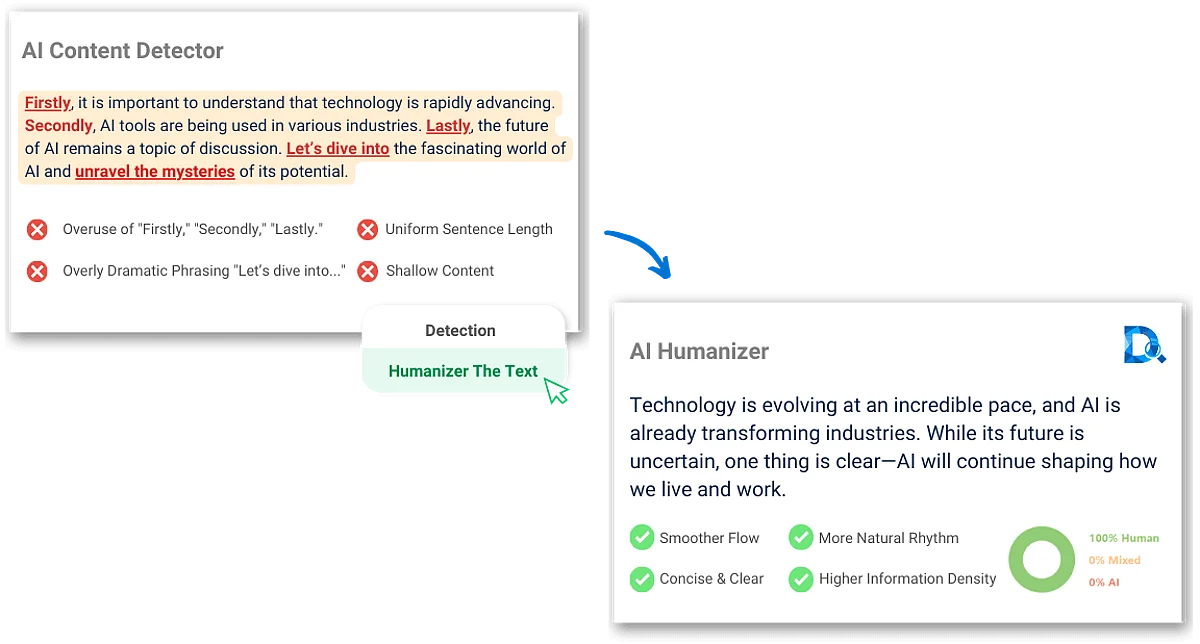Technology
Transforming AI Content: How Humanizers Enhance Engagement

In a rapidly evolving digital landscape, businesses and content creators increasingly rely on AI-generated text for various applications. Tools such as ChatGPT, Jasper, and Copy.ai enable the swift production of articles, advertisements, and social media posts. Despite their efficiency, AI-written content often struggles to convey the warmth and emotional resonance typical of human writing. This challenge has led to the emergence of a new tool known as the Content Humanizer, which aims to bridge the gap between mechanical text and engaging, relatable content.
Understanding the Role of Content Humanizers
A Content Humanizer serves as a specialized tool that transforms AI-generated text into a more human-like narrative. These tools analyze various aspects of writing, including tone, sentence structure, and vocabulary, to infuse the content with emotion and personality. The result is a piece of writing that not only informs but also connects with readers on a personal level. For example, where an AI might state, “Our product improves productivity by 25% and reduces workload,” a Content Humanizer would rephrase it to say, “With our product, you’ll achieve more in less time — allowing you to enjoy those stress-free evenings you’ve been longing for.” The revised version feels more conversational and inviting, resonating better with today’s audience.
Why Content Humanizers Are Essential
As more organizations utilize AI detection tools, such as AI Detector, to identify machine-generated text, the importance of humanized content becomes evident. If AI-generated material fails these checks, it risks being flagged or losing credibility. Content Humanizers help rewrite AI text to pass these detectors while retaining the core message. By adjusting phrasing, sentence length, and overall style, these tools can make text indistinguishable from human writing.
Moreover, readers can instinctively detect robotic language. Stiff phrasing or overly formal tone can disengage audiences. A humanized version of content employs emotional triggers and relatable language, drawing readers in. For instance, a blog about productivity tools should reflect the perspective of someone who has faced the pressures of deadlines, rather than a machine devoid of human experience.
Search engines, including Google, are evolving as well. They now prioritize content that demonstrates genuine expertise, experience, and empathy—often referred to as E-E-A-T (Experience, Expertise, Authoritativeness, Trustworthiness). AI-generated text frequently lacks the depth and perspective necessary to meet these criteria. By incorporating a Content Humanizer, content creators can enhance readability, increase user engagement, and improve the likelihood of shares and backlinks, all of which contribute positively to search engine optimization (SEO) rankings.
How Content Humanizers Function
Content Humanizers typically rely on advanced natural language processing (NLP) and rewriting algorithms. Their operation can be summarized in a few steps:
1. **Analyze the AI Text**: The tool evaluates tone, sentence structure, and predictability of language.
2. **Detect Robotic Patterns**: It identifies overly structured or repetitive sentences that lack a human touch.
3. **Reconstruct Human Flow**: Using linguistic models, it rewrites the text with more natural phrasing and varied rhythm.
4. **Check for Authenticity**: Finally, the tool ensures that the revised version can pass AI detection checks, making it suitable for publication.
Best Practices for Humanizing AI Content
Even the most sophisticated tools require a thoughtful approach. Here are several strategies to effectively humanize AI-generated content:
– **Vary Sentence Structure**: Human writing naturally varies in sentence length and complexity. By mixing short and long sentences, the text feels more organic. For example, “AI content is fast. But speed doesn’t mean connection. That’s where human touch makes all the difference.”
– **Add Emotional Connect**: If the content comes across as flat, infuse it with personal insights, humor, or empathy. Instead of a bland statement like, “The product has multiple features,” consider, “You’ll love exploring the features — it’s like discovering hidden gems that will make your day easier.”
– **Use Active Voice**: Passive constructions can sound dull. For instance, replace “The data was analyzed by the system” with “The system analyzed the data in seconds.” Active voice brings clarity and energy, essential qualities of engaging writing.
– **Include Real-World Examples**: Since AI lacks personal experience, humanizing content with relatable anecdotes or metaphors can enhance engagement. For example, likening a Content Humanizer to a personal editor who ensures the writing reflects a human voice adds depth.
– **Manually Proofread**: After utilizing a Content Humanizer, it is wise to proofread the content. Look for opportunities to inject unique voice and warmth, which are crucial for maintaining reader interest.
The Benefits of Using Content Humanizers
The adoption of Content Humanizers is becoming increasingly vital for content creators, marketers, and SEO professionals. Here are some key advantages:
– **Enhanced Relatability**: Readers are more likely to connect with content that sounds genuine. A humanizer maintains that personal touch while allowing for efficient content production.
– **Faster Quality Output**: Instead of manually editing each AI-generated piece, a Content Humanizer automates the process, enabling quicker turnaround times for quality content.
– **Stronger Audience Connections**: Engaging and emotionally resonant content fosters greater trust and can lead to improved sales or lead conversions.
– **Compliance with Quality Standards**: As search engines impose stricter content quality regulations, humanized text ensures that websites remain credible and trustworthy.
A Real-World Application
Consider a digital marketing agency producing 50 blog posts monthly using AI. Initially, they observed high bounce rates, indicating low reader engagement. After integrating a Content Humanizer into their process, the tone became more conversational, leading to a notable improvement. Within two months, the average time spent on their pages increased by 37%, while organic shares nearly doubled. This illustrates the significant impact of making content feel more human.
When to Utilize a Content Humanizer
Content Humanizers should be employed in various scenarios, including:
– When publishing AI-generated blog articles, social media posts, or advertisements.
– When submitting content to clients or platforms that utilize AI detection tools.
– When aiming to enhance tone, flow, and reader connection in bulk-written content.
Essentially, any time there is a need for human-sounding text produced efficiently, a Content Humanizer proves to be an invaluable resource.
In conclusion, while AI has revolutionized the speed of content creation, it has not replaced the fundamental purpose of writing: to connect, inspire, and engage. The use of a Content Humanizer allows creators to merge the efficiency of AI with the essential qualities of human creativity. By leveraging reliable tools alongside detection mechanisms, content can be produced that is both authentic and enjoyable to read. Ultimately, success in content creation lies in engaging with audiences, and that is precisely what a well-humanized piece of writing accomplishes.
-

 Technology4 months ago
Technology4 months agoDiscover the Top 10 Calorie Counting Apps of 2025
-

 Health2 months ago
Health2 months agoBella Hadid Shares Health Update After Treatment for Lyme Disease
-

 Health3 months ago
Health3 months agoErin Bates Shares Recovery Update Following Sepsis Complications
-

 Technology3 weeks ago
Technology3 weeks agoDiscover 2025’s Top GPUs for Exceptional 4K Gaming Performance
-

 Technology4 months ago
Technology4 months agoDiscover How to Reverse Image Search Using ChatGPT Effortlessly
-

 Technology2 months ago
Technology2 months agoElectric Moto Influencer Surronster Arrested in Tijuana
-

 Technology4 months ago
Technology4 months agoMeta Initiates $60B AI Data Center Expansion, Starting in Ohio
-

 Technology4 months ago
Technology4 months agoRecovering a Suspended TikTok Account: A Step-by-Step Guide
-

 Health4 months ago
Health4 months agoTested: Rab Firewall Mountain Jacket Survives Harsh Conditions
-

 Lifestyle4 months ago
Lifestyle4 months agoBelton Family Reunites After Daughter Survives Hill Country Floods
-

 Technology3 months ago
Technology3 months agoUncovering the Top Five Most Challenging Motorcycles to Ride
-

 Technology4 weeks ago
Technology4 weeks agoDiscover the Best Wireless Earbuds for Every Lifestyle





















